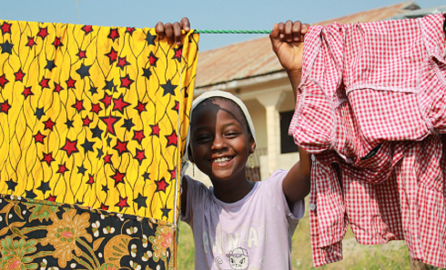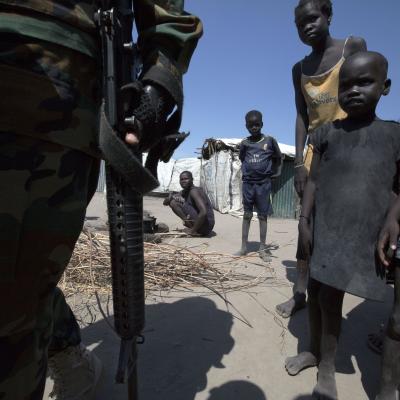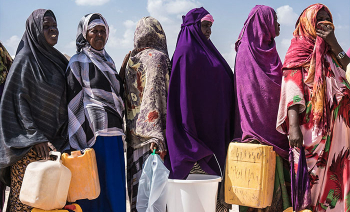In 2017, several European Union Delegations were asked to operationalise the Humanitarian-Development-Peace Nexus to better navigate fragility, address roots of conflicts and adopt a new development approach. Three years later, Capacity4dev met with the Delegations in Nigeria and Myanmar to hear about their experiences.
Creating better coordination and strategic thinking is key to the Humanitarian, Development Peace Nexus (HDP Nexus). Joint and collaborative approaches are critical to delivering on the Nexus so as to enhance coherence and complementarity. This starts at home by strengthening the links between the European External Action Service (EEAS), the Directorate-General "International Cooperation and Development" (DEVCO) and the Directorate-General "Humanitarian Aid" (ECHO).
The complexity of coordination and scope definition for the nexus in Nigeria
In Nigeria, the benefits of the HDP Nexus approach are clear to many. Operationalising it, however, is a major challenge. Kurt Cornelis, Head of Cooperation at the EU Delegation to Nigeria, took part in a training organised in Brussels. Two years into piloting the HDP Nexus, he outlined the complexity of this concept in the West African country.
“Instead of operating on our own in 2016, we (DEVCO) involved ECHO in the Recovery and Peacebuilding Assessment nexus (RPBA), which included the World Bank Group and the United Nations. Access was limited to certain parts in the North East, so we partnered with long-lasting civil society organisations that ECHO collaborated with. They had the necessary experience, skills and contacts to access difficult areas. It was a win-win situation. DEVCO awarded funds to ECHO partners and it all evolved from pure humanitarian work to an approach that included immediate response, development and peace work.”
The continuation of the conflict in the North East of Nigeria created a complex crisis. In 2018, whole sections of Borno state were hard to reach, reducing access for humanitarian and development partners. DEVCO and ECHO still operated together, but collaboration with other international stakeholders became increasingly difficult.
“There was, and still is, a huge number of different actors involved, with different interpretations and understanding of the situation. Humanitarian, development and peace activities remain separate interventions for most stakeholders leading to confusion and problems.”
Capitalising on opportunities
Opportunities exist and need to be supported. “The UN embraced the HDP nexus concept, and could play a leading role,” said Cornelis, “despite its shortcomings, the UNDP Stabilisation Facility for Lake Chad has brought all major (political, military, diplomatic) stakeholders together in its Board for the Nigeria window. We should capitalise on this.”
Efforts are being made to build trust between all nexus actors. The new Minister of Humanitarian Affairs is actively participating in this process. In the wider Lake Chad Basin, the Stabilisation Strategy is one of the mechanisms, which could potentially gather international stakeholders around an effective and operationalised nexus.
Reinforcing the collaboration between ECHO and DEVCO should inspire other key partners, locals and internationals, to step up in Nigeria. Nevertheless, the conflict is complex, and its actors are numerous. Expectations about nexus results should, therefore, remain realistic for the short and medium-term.
A flexible and adaptative approach in Myanmar
Another HDP Nexus experience is taking place in Myanmar. In December 2019, the Delegation to Myanmar launched the “Nexus Response Mechanism” (NRM) to address the conflict in the South-East Asian republic. One key feature of this tool includes a funding mechanism. The NRM specifically aims at providing support to conflict-affected populations, displaced populations, host communities and returnees.
Three features for testing success
“The fund has three main features, which I think are particularly interesting”, said Pedro Campo Llopis, Deputy Head of Cooperation at the Delegation to Myanmar speaking in Brussels in February 2020.
First, the fund is operated by DEVCO with ongoing collegial consultation with colleagues from ECHO and EEAS. Second, it operates a flexible adaptative approach, allowing regular assessment and reallocation of funds. “If activities don’t work, because the context of the conflict is changing, we can stop the action and move resources from one place to another. This type of flexibility is fundamental to work in an uncertain context”, said Campo Llopis.
The third feature is related to the capacity of the fund to have a so-called ‘third Party Monitoring’ informing joint decision and embedding due diligence criteria in the NRM. The Delegation is therefore assisted by a team of experts, which are not competing for funding. They regularly provide analysis of EU funded programmes to keep monitoring the evolution of conflict dynamics and check against due diligence criteria approved by the Delegation in advance. They also produce quarterly monitoring reports on EU-funded projects, keeping the pulse on project effectiveness and pertinence in ever-changing field dynamics.
In the following video, Pedro Campo Llopis shares insights into the "Nexus Response Mechanism" in Myanmar.
“The conflict changes and context are evolving so quickly that they (implementing partners) are sometimes unaware of how their operations relate to the policies and the environment in which they operate”, explains Campo Llopis. This analytical capacity provides a unique source of information specifically dedicated to the Delegation, which used to rely on other international sources of information. This mechanism will allow to tailor conflict analysis to the needs of the Delegation itself.
This approach is about testing durable solutions and addressing the underlying root causes of vulnerability, fragility and conflict while simultaneously aiming to meet immediate humanitarian needs to protect and strengthen resilience, political dialogue and peace. A key determinant of this approach is to catch risks as they arise and respond smartly to them.
Lessons learnt from the EUDs to Myanmar and Nigeria Humanitarian-Development-Peace Nexus:
- Plan for an integrated approach linking immediate response, development and peace work.
- Build trust between all nexus actors.
- From the start, establish consultative processes between ECHO/DEVCO/EEAS.
- Go deep in your contextual analyses, triangulate, collect first-source information and tailor your action.
Please note that all HDP Nexus experiences are open to discussion. They are not EU guidelines.
Credit: Videos © Capacity4dev | Photo © by Muhammadtaha Ibrahim Ma'aji on Unsplash



Log in with your EU Login account to post or comment on the platform.